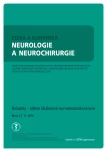The Relevance of Pressure Mapping System in Wheelchair Mobility
Authors:
L. Vašíčková 1–3; J. Siegelová 2; M. Mašek 1
Authors place of work:
Spinální jednotka, Klinika úrazové chirurgie LF MU a FN Brno
1; Katedra fyzioterapie a rehabilitace, LF MU, Brno
2; Ústav ochrany a podpory zdraví, LF MU, Brno
3
Published in the journal:
Cesk Slov Neurol N 2016; 79/112(Supplementum1): 15-19
Category:
Původní práce
doi:
https://doi.org/10.14735/amcsnn2016S15
Summary
Aim:
The aim of the study was to evaluate the use of the Pressure Mapping System (PMS) to comprehensively evaluate spinal cord-injured (SCI) patients with wheelchair mobility.
Materials and methods:
A cohort of 29 patients with both traumatic and non-traumatic aetiology was analysed. The patients were examined at the spinal outpatient clinic for life-long care at the University Hospital Brno in 2015. The examination included detailed medical history, clinical evaluation while sitting in a wheelchair, laying and sitting on an examination couch, clinical evaluation of pressure on a seating cushion using PMS, photo documentation of sitting in a wheelchair.
Results:
Of the total of 21 men and eight women with SCI, 26 had a traumatic lesion (20 men and six women). Three (one man and two women) had non-traumatic aetiology. All were mobile on a mechanical wheelchair. The distribution of pressure on a seating cushion showed that the pressure under ischial tuberosities was lower than 100 mm Hg in 10 patients (mean 80 ± 24 mm Hg left, 91 ±± 24 mm Hg right). Unilateral pathology of pressure above 100 mm Hg under an ischial tuberosity was found in 12 patients (mean 93 ± 21 mm Hg left, 103 ± 36 mm Hg right). We found bilateral pathology of pressure over 100 mm Hg under both ischial tuberosities in seven patients (mean 128 ±± 19 mm Hg left and 117 ± 21 mm Hg right). Statistically significant differences in pressure were only found under the left ischial tuberosity.
Conclusion:
We verified that examination with PMS is an appropriate element of comprehensive assessment of patients with wheelchair mobility.
Key words:
wheelchair mobility – spinal cord injury –pressure mapping system Conformat – pressure ulcers – sitting posture
The authors declare they have no potential conflicts of interest concerning drugs, products, or services used in the study.
The Editorial Board declares that the manuscript met the ICMJE “uniform requirements” for biomedical papers.
Zdroje
1. Bickenbach J, Officer A, Shakespeare T, et al. International Spinal Perspectives on Spinal Cord Injury. Geneva: World Health Organization 2013.
2. Stockton L, Gebhardt KS, Clark M. Seating and pressure ulcers: clinical practice guideline. J Tissue Viability 2009;18(4):98 – 108. doi: 10.1016/ j.jtv.2009.09.001.
3. Vašíčková L. Dobře pracovat na vozíku vyžaduje dobře sedět. 1st ed. Brno: ParaCENTRUM Fenix 2015.
4. Frisbie JH, Sharma GV. The prevalence of pulmonary embolism in chronically paralyzed subject: a review of available evidence. Spinal Cord 2012;50(6):400 – 3. doi: 10.1038/ sc.2011.154.
5. Miller H, Delozier J. Cost implications of the pressure ulcer treatment guideline. Columbia (MD): Centre for Health Policy Studies, Agency for Health Care Policy and Research 1994.
6. Russo CA, Elixhauser A. Hospitalization related to pressure sores, 2003. Healthcare Cost and Utilization Project (HCUP) Statistical Brief #3. Rockville (MD): Agency Healthcare Research and Quality 2006.
7. Romanelli M, Clark M, Cherry G, et al. Science and Practice of Pressure Ulcer Management. London (UK): Springer-Verlag Limited 2006.
8. Stinson MD, Porter-Armstrong AP, Eakin PA. Pressure mapping system: reliability of pressure map interpretation. Clin Rehabil 2003;17(5):504 – 11.
9. Ferguson-Pell M, Cardi MD. Prototype development and comparative evaluation of wheelchair pressure mapping system. Assist Technol 1993;2(5):78 – 91. doi: 10.1080/ 10400435.1993.10132213.
10. Crawford SA, Stinson MD, Walsh DM, et al. Impact of sitting time on seat-interface pressure and on pressure mapping with multiple sclerosis patients. Arch Phys Med Rehabil 2005;86(6):1221 – 5. doi: 10.1016/ j.apmr.2004.08.010.
11. Engström B. Ergonomic Seating. Germany: Posturalis Books 2003.
12. Alm M, Saraste H, Norribrink C. Shoulder pain in persons with thoracic spinal cord injury: Prevalence and characteristics. J Rehab Med 2008;40(4):277 – 83. doi: 10.2340/ 16501977-0173.
13. Michailidou C, Marston L, De Souza LH, et al. A systematic review of the prevalence of musculoskeletal pain, back and low back pain in people with spinal cord injury. Disabil Rehabil 2014;36(9):705 – 15. doi: 10.3109/ 09638288.2013.808708.
14. Eslami V, Saadat S, Habibi Arejan R, et al. Factors associated with the development of pressure ulcers after spinal cord injury. Spinal Cord 2012;50(12):899 – 903. doi: 10.1038/ sc.2012.75.
15. Tederko P, Besowski T, Jakubiak K, et al. Influence of wheelchair footrest height on ischial tuberosity pressure in individual with paraplegia. Spinal Cord 2015;53(6):471 – 5. doi: 10.1038/ sc.2014.242.
16. Bolin I, Bodin P, Kreuter M. Sitting position – posture and performance in C5 – C6 tetraplegia. Spinal Cord 2000;38(7):425 – 34.
17. Gupta N, Loong B, Leong G. Comparing and contrasting knowledge of pressure ulcer assessment, preventive and management in people with spinal cord injury among nursing staff working in two metropolitan spinal units and rehabilitation medicine training specialists in a free-way comparison. Spinal Cord 2012;50(2):159 – 64. doi: 10.1038/ sc.2011.88.
18. Pokorná A, Leaper D. Assessment and documentation of non-healing, chronic wounds in inpatient health care facilities in the Czech Republic: an evaluation study. Int Wound J 2015;12(2):224 – 31. doi: 10.1111/ iwj.12372.
Štítky
Dětská neurologie Neurochirurgie NeurologieČlánek vyšel v časopise
Česká a slovenská neurologie a neurochirurgie

2016 Číslo Supplementum1
- Neuropatie u diabetu: Proč ji nepřehlédnout a kdy myslet i na deficit vitaminů B?
- Metamizol jako analgetikum první volby: kdy, pro koho, jak a proč?
- Nejčastější nežádoucí účinky venlafaxinu během terapie odeznívají
- Zolpidem může mít širší spektrum účinků, než jsme se doposud domnívali, a mnohdy i překvapivé
Nejčtenější v tomto čísle
- Sorrorigenní rány, jejich identifikace a průběh péče
- Inkontinenční dermatitida – současné poznatky o etiologii, diagnóze a prevenci
- Význam a možnosti chirurgického débridementu dekubitů
- Význam tlakové mapy (pressure mapping system) pro pacienty s mobilitou na vozíku
